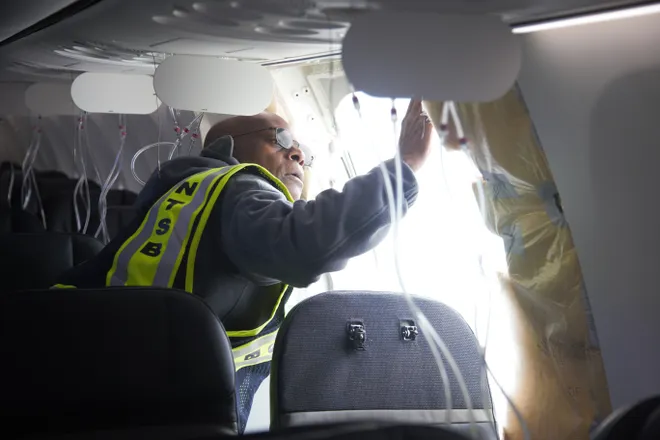An iPhone fell from an Alaska Airlines flight and still works. Scientists explain how.
Even as serious questions emerged about why a door plug flew off one of Alaska Airlines’ new Boeing jets last week and forced an emergency landing, one question was on the mind of many cellphone users: How in the world did an iPhone reportedly fall 16,000 feet from the aircraft and survive intact?
Social media channels were abuzz with discussion and speculation over how the phone could have still been operable and whether the phone’s survival might find its way into an advertising campaign. USA TODAY reached out to two scientists who explained how physics would have played a role.
David Rakestraw, a senior scientist at the Lawrence Livermore National Laboratory in California, works with students as part of the laboratory's science and math education program. He often talks with students about cellphones, phone drop tests, and how students can do sophisticated experiments with their phones.
In this case, at least three things would have worked in the phone’s favor, Rakestraw explained.
First, phone manufacturers have been working to make phones stronger, given the number of tumbles our mobile devices take, from much shorter distances. Phone cases and screen protectors also help protect a phone when it falls, he said. And finally, where the phone landed might have made all the difference.
How was the cellphone found?
A man in Vancouver, Washington, Sean Bates, posted on X that he found the iPhone on Sunday after the National Transportation Safety Board asked people who live in the area to search for any pieces that might have fallen from the jet.
Bates told a local television station he found the phone alongside a road, under a bush. He said the phone was still in airplane mode, with a baggage receipt for the Alaska Airlines flight still on its screen.
Bates turned the phone over to the NTSB, and on Monday, the safety board’s chair, Jennifer Homendy, posted a message on X to Bates thanking him for his help.
The model of the phone or the case manufacturer wasn't yet known.
How did the phone survive?
When anything moving is dropped, it has momentum – mass times velocity, Rakestraw said. What matters is when the object stops and what stops it. He compared it to hitting a brick wall versus falling on a pillow. The pillow slows the impact over a longer period of time than the brick wall.
It’s the reason passenger cars and trucks have airbags: to absorb the force by slowing the impact. It’s also the reason racetracks have Steel and Foam Energy Reduction (SAFER) barriers to protect drivers: by absorbing and reducing energy when a race car hits a wall.
Phone cases are made of material that flexes and gives upon impact, he said. “It has the ability to crunch a little bit.”

Slowing the momentum
The iPhone surely would have reached terminal velocity early in its fall, said Lou Bloomfield, an emeritus professor of physics at the University of Virginia. That means its downward velocity increased until the upward force of air resistance, also known as drag, “balanced the downward force of gravity (the iPhone's weight) so that the iPhone stopped accelerating downward and simply coasted at a constant velocity.”
The iPhone may have tumbled as it fell, so it countered stronger air resistance, he said. He estimated that the phone's velocity “wasn’t all that fast – probably less than 100 miles per hour and maybe significantly less than that.”
In experiments with falling pennies, pennies tumble and hit terminal velocity at about 25 mph, Bloomfield said. “A tumbling iPhone should flutter down like a big penny, traveling faster than a penny but not so fast that it can't tolerate an impact with a soft lawn.”
A key factor is where the phone would have fallen. If it had fallen just a few feet to the side and hit the road instead of the bushes, it could have been a different story, Rakestraw said. “The phone got lucky by hitting a natural environment where the momentum was slower."
It's likely the phone would have bounced among branches as it fell, further absorbing the impact of the fall before the phone hit the ground, he said.
"Phones are designed to take a pretty strong impulse,” he said. “We’re trying to make that impulse take place over a longer period of time.”
A worst-case scenario is for the corner of a phone to hit something hard.
How are cellphones helping science education?
Rakestraw and the students don't just study what happens with someone drops a cellphone. The lab works with students in a program to improve science, technology, engineering and mathematics (STEM) education.
The laboratory has developed a website with thousands of pages of experiments students can do with their smartphones, he said, and cellphones “allow the students at even the poorest-resourced high schools in the country to do better experiments” than those taking place at some of the best universities.
Disclaimer: The copyright of this article belongs to the original author. Reposting this article is solely for the purpose of information dissemination and does not constitute any investment advice. If there is any infringement, please contact us immediately. We will make corrections or deletions as necessary. Thank you.






